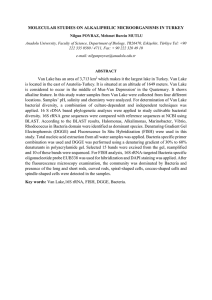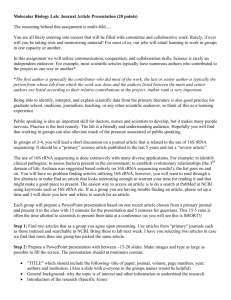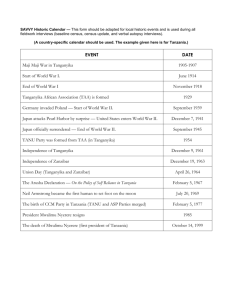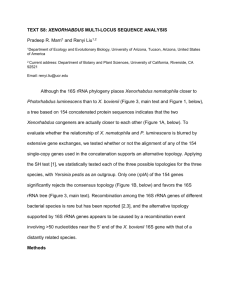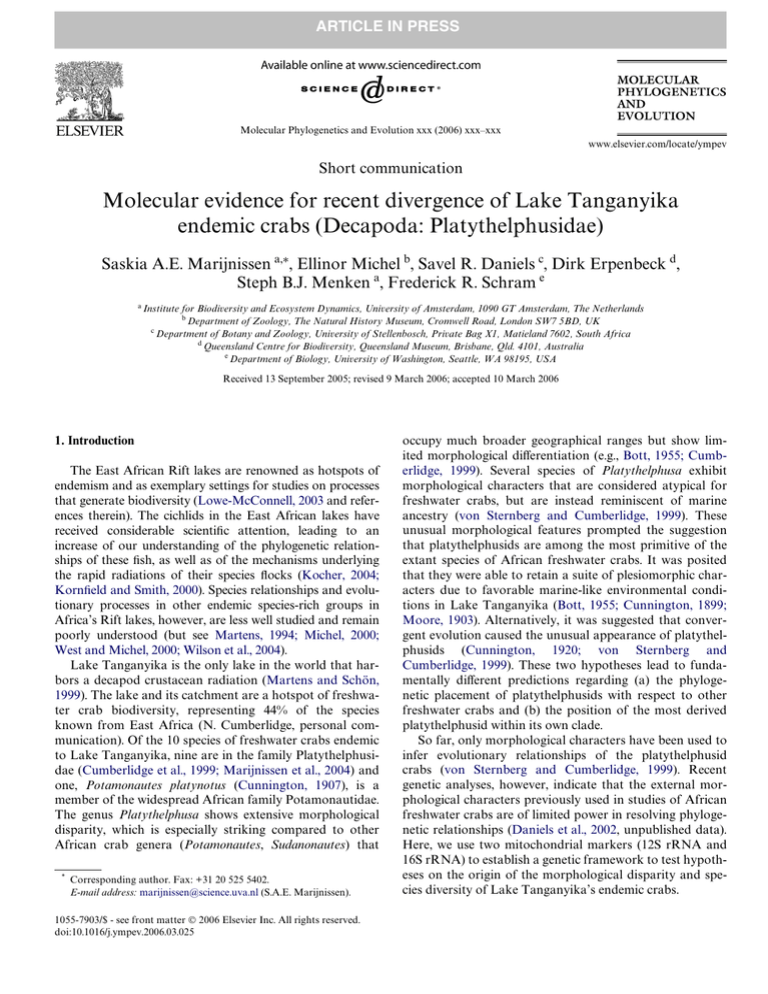
ARTICLE IN PRESS
Molecular Phylogenetics and Evolution xxx (2006) xxx–xxx
www.elsevier.com/locate/ympev
Short communication
Molecular evidence for recent divergence of Lake Tanganyika
endemic crabs (Decapoda: Platythelphusidae)
Saskia A.E. Marijnissen a,¤, Ellinor Michel b, Savel R. Daniels c, Dirk Erpenbeck d,
Steph B.J. Menken a, Frederick R. Schram e
a
Institute for Biodiversity and Ecosystem Dynamics, University of Amsterdam, 1090 GT Amsterdam, The Netherlands
b
Department of Zoology, The Natural History Museum, Cromwell Road, London SW7 5BD, UK
c
Department of Botany and Zoology, University of Stellenbosch, Private Bag X1, Matieland 7602, South Africa
d
Queensland Centre for Biodiversity, Queensland Museum, Brisbane, Qld. 4101, Australia
e
Department of Biology, University of Washington, Seattle, WA 98195, USA
Received 13 September 2005; revised 9 March 2006; accepted 10 March 2006
1. Introduction
The East African Rift lakes are renowned as hotspots of
endemism and as exemplary settings for studies on processes
that generate biodiversity (Lowe-McConnell, 2003 and references therein). The cichlids in the East African lakes have
received considerable scientiWc attention, leading to an
increase of our understanding of the phylogenetic relationships of these Wsh, as well as of the mechanisms underlying
the rapid radiations of their species Xocks (Kocher, 2004;
KornWeld and Smith, 2000). Species relationships and evolutionary processes in other endemic species-rich groups in
Africa’s Rift lakes, however, are less well studied and remain
poorly understood (but see Martens, 1994; Michel, 2000;
West and Michel, 2000; Wilson et al., 2004).
Lake Tanganyika is the only lake in the world that harbors a decapod crustacean radiation (Martens and Schön,
1999). The lake and its catchment are a hotspot of freshwater crab biodiversity, representing 44% of the species
known from East Africa (N. Cumberlidge, personal communication). Of the 10 species of freshwater crabs endemic
to Lake Tanganyika, nine are in the family Platythelphusidae (Cumberlidge et al., 1999; Marijnissen et al., 2004) and
one, Potamonautes platynotus (Cunnington, 1907), is a
member of the widespread African family Potamonautidae.
The genus Platythelphusa shows extensive morphological
disparity, which is especially striking compared to other
African crab genera (Potamonautes, Sudanonautes) that
*
Corresponding author. Fax: +31 20 525 5402.
E-mail address: marijnissen@science.uva.nl (S.A.E. Marijnissen).
1055-7903/$ - see front matter © 2006 Elsevier Inc. All rights reserved.
doi:10.1016/j.ympev.2006.03.025
occupy much broader geographical ranges but show limited morphological diVerentiation (e.g., Bott, 1955; Cumberlidge, 1999). Several species of Platythelphusa exhibit
morphological characters that are considered atypical for
freshwater crabs, but are instead reminiscent of marine
ancestry (von Sternberg and Cumberlidge, 1999). These
unusual morphological features prompted the suggestion
that platythelphusids are among the most primitive of the
extant species of African freshwater crabs. It was posited
that they were able to retain a suite of plesiomorphic characters due to favorable marine-like environmental conditions in Lake Tanganyika (Bott, 1955; Cunnington, 1899;
Moore, 1903). Alternatively, it was suggested that convergent evolution caused the unusual appearance of platythelphusids (Cunnington, 1920; von Sternberg and
Cumberlidge, 1999). These two hypotheses lead to fundamentally diVerent predictions regarding (a) the phylogenetic placement of platythelphusids with respect to other
freshwater crabs and (b) the position of the most derived
platythelphusid within its own clade.
So far, only morphological characters have been used to
infer evolutionary relationships of the platythelphusid
crabs (von Sternberg and Cumberlidge, 1999). Recent
genetic analyses, however, indicate that the external morphological characters previously used in studies of African
freshwater crabs are of limited power in resolving phylogenetic relationships (Daniels et al., 2002, unpublished data).
Here, we use two mitochondrial markers (12S rRNA and
16S rRNA) to establish a genetic framework to test hypotheses on the origin of the morphological disparity and species diversity of Lake Tanganyika’s endemic crabs.
ARTICLE IN PRESS
2
S.A.E. Marijnissen et al. / Molecular Phylogenetics and Evolution xxx (2006) xxx–xxx
2. Materials and methods
Platythelphusid crabs were collected from 11 localities
along the Tanzanian and Zambian shoreline of Lake Tanganyika between 2001 and 2003 (Table 1). We included representatives for eight of the nine species of the endemic
Tanganyikan genus Platythelphusa. For seven of these we
included multiple representatives, however a single
individual of Platythelphusa praelongata was available (see
Marijnissen et al., 2004). Extensive eVorts to collect Platythelphusa polita were unsuccessful at the sites surveyed.
Crabs were collected either by hand through SCUBA diving, or obtained from local Wshermen (Platythelphusa tuberculata, P. praelongata, and outgroup taxa), and preserved in
95% ethanol. Vouchers were deposited at the Zoological
Museum Amsterdam (ZMA De. 204594–96, De. 204686–
95). Sequences from six mitochondrial and nuclear genes
indicated that Platythelphusa nests robustly within East
African potamonautid crabs (Daniels et al., unpublished
data), so we included a range of potamonautids for outgroup sampling: the Tanganyikan endemic P. platynotus,
the East African representatives P. emini, P. lirrangensis,
andP. niloticus and three species from southern Africa,
P. brincki, P. clarus, and P. depressus (Table 1).
Total genomic DNA was extracted from muscle tissue
of each crab, following standard procedures outlined by
Daniels et al. (2002). Two primer sets, 12S rRNA
(Kocher et al., 1989) and 16S rRNA (Palumbi et al.,
1991), were used to amplify each of the two mitochondrial gene regions using standard polymerase chain reaction (PCR) methods. Individual 25 l PCR contained
14.9 l millipore water, 3 l of 25 mM MgCl2, 2.5 l of
10£ Mg 2+ free buVer, 0.5 l of a 10 mM dNTP solution,
and 0.5 l of each primer set (at 10 M each), 0.1 l of Taq
polymerase, and 1 l template DNA. PCR conditions
were as follows: 3 min at 95 °C, then 32 cycles of 95 °C for
35 s, 48 °C for 45 s, 72 °C for 40 s, followed by 48 °C for
5 min, 72 °C for 10 min, and 20 °C for 10 min. PCR products were puriWed using a QIAquick PCR puriWcation kit
(Qiagen), then cycle sequenced following standard protocols (3 l puriWed PCR product, 4 l ABI PRISM Xuorescent dye terminators, 3 l of a 1 M of primer solution),
followed by analysis on an ABI 3100 automated DNA
sequencer.
Table 1
Specimens of Platythelphusa and Potamonautes included in the phylogenetic analyses, localities where crabs were collected, and GenBank Accession
numbers
Species
Code
Locality
Latitude, longitude
12S
16S
Platythelphusa armata (A. Milne-Edwards, 1887)
Platythelphusa armata
Platythelphusa armata
Platythelphusa conculcata (Cunnington, 1907)
Platythelphusa conculcata
Platythelphusa conculcata
Platythelphusa denticulata (Capart, 1952)
Platythelphusa denticulata
Platythelphusa echinata (Capart, 1952)
Platythelphusa echinata
Platythelphusa echinata
Platythelphusa immaculata (Marijnissen et al., 2004)
Platythelphusa immaculata
Platythelphusa immaculata
Platythelphusa maculata (Cunnington, 1899)
Platythelphusa maculata
Platythelphusa maculata
Platythelphusa praelongata (Marijnissen et al., 2004)
Platythelphusa tuberculata (Capart, 1952)
Platythelphusa tuberculata
JKB
MBT
UJJ
HTP
JKB
KIG
KAB
MZG
HTP
MPL
UJJ
JKB
KTB
MBT
KAS
KMJ
MPL
MPL
UJJ
MBT
Jakobsen
Mbita
Ujiji
Hilltop
Jakobsen
Kigoma
Kabwe
Mzungu
Hilltop
Mpulungu
Ujiji
Jakobsen
Katabe
Mbita
Kasanga
Kangamoja
Mpulungu
Mpulungu
Ujiji
Mbita
LT, TZ
LT, ZM
LT, TZ
LT, TZ
LT, TZ
LT, TZ
LT, TZ
LT, TZ
LT, TZ
LT, ZM
LT, TZ
LT, TZ
LT, ZM
LT, TZ
LT, TZ
LT, TZ
LT, ZM
LT, ZM
LT, TZ
LT, ZM
4°54.87⬘S, 29°35.85⬘E
8°45.23⬘S, 31°05.14⬘E
4°58.00⬘S, 29°41.82⬘E
4°53.20⬘S, 29°36.90⬘E
4°54.73⬘S, 29°35.90⬘E
4°53⬘21⬘S, 29°37.21⬘E
7°01.60⬘S, 30°33.00⬘Ea
4°55.05⬘S, 29°35.73⬘E
4°53.45⬘S, 29°35.80⬘E
N.A.
4°58.75⬘S, 29°43.27⬘E
4°54.73⬘S, 29°35.90⬘E
4°54.21⬘S, 29°35.67⬘E
8°45.23⬘S, 31°05.14⬘E
8°28.00⬘S, 31°08.60⬘Ea
4°57.92⬘S, 29°41.20⬘E
8°45.99⬘S, 31°06.40⬘E
8°45.22⬘S, 31°05.14⬘E
4°54.20⬘S, 29°30.00⬘Ea
8°44.91⬘S, 31°05.34⬘E
DQ203187
DQ203188
DQ203189
DQ203190
DQ203191
DQ203192
DQ203194
DQ203193
DQ203196
DQ203197
DQ203195
DQ203199
DQ203200
DQ203198
DQ203201
DQ203202
DQ203203
DQ203204
DQ203206
DQ203205
DQ203213
DQ203214
DQ203215
DQ203216
DQ203217
DQ203218
DQ203220
DQ203219
DQ203222
DQ203223
DQ203221
DQ203225
DQ203226
DQ203224
DQ203227
DQ203228
DQ203229
DQ203230
DQ203232
DQ203231
Potamonautes emini (Hilgendorf, 1892)
Potamonautes emini
Potamonautes niloticus (H. Milne-Edwards, 1837)
Potamonautes lirrangensis (Rathbun, 1904)
Potamonautes lirrangensis
Potamonautes lirrangensis
Potamonautes platynotus (Cunnington, 1907)
Potamonautes clarus (Gouws et al., 2000)
Potamonautes brincki (Bott, 1960)
Potamonautes depressus (Krauss, 1843)
GMB
KIV
SRD
KIV
MAL
ZAM
KAL
OLI
FER
COL
Gombe
Ruzizi
N.A.
Ruzizi
Thumbi West
Uazua
Kalemie
Oliviershoekpas
Fernkloof
Coleford
LT, TZ
LK, DC
N.A.
LK, DC
LM, MW
LT, ZM
LT, DC
KZ, SA
WC, SA
KZ, SA
4°38.15⬘S, 29°37.81⬘E
N.A.
N.A.
N.A.
N.A.
N.A.
5°55.60⬘S, 29°11.60⬘Ea
N.A.b
N.A.b
N.A.b
DQ203207
DQ203208
AY803496
DQ203210
DQ203209
DQ203211
DQ203212
AY042320
AY042322
AY042325
DQ203233
DQ203234
AY803536
DQ203236
DQ203235
DQ203237
DQ203238
AY042241
AY042244
AY042247
DC, Democratic Republic Congo; KZ, Kwa Zulu Natal; LK, Lake Kivu; LM, Lake Malawi; LT, Lake Tanganyika; MW; Malawi; SA, South Africa; TZ,
Tanzania; WC, Western Cape; ZM, Zambia; SRD, sequences provided by Savel Daniels; N.A., not available.
a
Indicates location not veriWed with GPS.
b
Samples from Daniels et al. (2002).
ARTICLE IN PRESS
S.A.E. Marijnissen et al. / Molecular Phylogenetics and Evolution xxx (2006) xxx–xxx
Sequences were aligned in CLUSTALX 1.81 (Thompson
et al., 1997) under default settings and optimized manually
(Page and Holmes, 1998). Although this methodology is
widely used, it should be noted that it has received criticism
due to its sensitivity to arbitrary selection of alignment
parameters (e.g., Giribet, 2003, and references therein).
Regions that could not be unambiguously aligned were
identiWed, and the eVect of omitting those from the analyses
was tested. A partition homogeneity test was carried out in
PAUP* 4b10 (SwoVord, 2002) to test for congruence
among the genes (Farris et al., 1994). MODELTEST 3.06
(Possada and Crandall, 1998) was used to determine the
best-Wt model of sequence evolution under the Akaike
information criterion (AIC). Phylogenetic analyses were
reconstructed using maximum likelihood and parsimony
procedures in PAUP* 4b10 under default settings. Maximum likelihood and parsimony analyses were performed
using heuristic searches and TBR branch swapping with 10
random additions. Bootstrap support was calculated over
100 and 1000 permutations for maximum likelihood and
parsimony, respectively. Bayesian trees were inferred using
MrBayes 3.0b4 (Ronquist and Huelsenbeck, 2003). Bayesian inference of phylogeny (BI) was performed using eight
Markov chains, 10 million generations with a burn-in of
10%. The posterior distributions were approximated three
times under the Bayesian approach, to determine successful
convergence of the Markov chains. All the analyses above
were performed on the separate data sets of 12S and 16S
rRNA, as well as on the combined data set. To obtain an
approximation of the relative timeframe of platythelphusid
diversiWcation a molecular clock was applied to the 16S
rRNA sequence data set. A likelihood ratio test was carried
out to the 16S rRNA data in PAUP* 4b10 prior to performing molecular clock inferences. Divergence time estimates were obtained by applying a rate of 0.0032–0.0045
substitutions per site per lineage per million years to corrected divergence values. This rate corresponds to estimates
obtained for taxa in the marine crab genera Sesarma and
Uca, which range from t0.65% to t0.9% pairwise sequence
divergence per million years (Ma) for 16S rRNA (Schubart
et al., 1998a,b; Sturmbauer et al., 1996).
3. Results
Both 12S rRNA and 16S rRNA exhibited heterogeneity
in sequence variation. Exclusion of regions of ambiguous
alignments, which were primarily between ingroup and outgroup taxa, resulted in no loss of ingroup phylogenetic signal. The combined 12S and 16S rRNA sequence data
included 754 base pairs, with 127 variables and 66 parsimony informative sites. The results from the partitionhomogeneity test were not signiWcant, and thus the 12S and
16S rRNA genes were combined in the analyses. The bestWt maximum likelihood model was chosen using the AIC.
The TVM+I maximum likelihood model was selected for
12S rRNA, and GTR + I for 16S rRNA, whereas the
GTR + I + G model was selected for the combined data set.
3
Similarity of log likelihood values after burn-in, indicated
that the Markov chains successfully reached convergence
during all three Bayesian runs.
The platythelphusids from Lake Tanganyika form a well
supported clade in all analyses (Fig. 1). Potamonautes emini
and a clade consisting of P. niloticus, the Tanganyikan
endemic P. platynotus and P. lirrangensis were placed sister
to the Platythelphusidae. Average 12S rRNA and 16S
rRNA sequence divergence (uncorrected p-distances)
between Platythelphusa individuals was 1.21% (range 0.4–
2.7%), 8.94% (range 0.1–11.5%) within the potamonautid
outgroup, and the minimum divergence between the
ingroup and outgroup was 7.56%. The hypothesis of a
molecular clock was not rejected (2 D 33.7 df D 29 P > 0.05).
Applying a molecular clock of 0.65–0.9% sequence divergence per Myr to the 16S rRNA sequence data suggests
that the platythelphusid lineage separated from Potamonautidae approximately 9.0–6.5 Myr ago, while divergence
of the platythelphusid clade is estimated to have taken
place approximately 3.3–2.5 Myr ago (node C1 and C2,
respectively in Fig. 1).
The combined 12S and 16S rRNA data set resolved
some, but not all species relationships within Platythelphusidae (Fig. 1). The diVerent phylogenetic reconstruction
methods resulted in congruent topologies for the combined
data set, however, separate analysis of the 12S and 16S
rRNA sequences diVer in the position of several individuals: (i) P. armata JKB (respectively unresolved, and sister to
P. armata UJJ), (ii) P. denticulata MZG (in a clade with P.
maculata KAB and P. maculata MPL, and sister to P. maculata KMJ), (iii) P. maculata KAS (in an unresolved clade
with P. armata MBT, P. armata UJJ and P. maculata KMJ,
and sister to denticulata KAB, and (iv) P. immaculata KTB
(sister to P. echinata UJJ, and in a polytomy with P. immaculata and P. conculcata) (data not shown).
4. Discussion
The platythelphusids from Lake Tanganyika are the
Wrst example of a recent diversiWcation among African
freshwater crabs. The phylogenetic patterns recovered by
our analyses of 12S and 16S rRNA mtDNA sequences
reveal that Platythelphusidae is an unequivocal genetic
clade, with surprisingly short internal branches. The
endemic Tanganyikan potamonautid P. platynotus does
not cluster with the platythelphusids, and instead it is sister to the widespread East African P. lirrangensis. The
12S and 16S rRNA mtDNA genes did not resolve phylogenetic patterns within Platythelphusidae well enough to
conWdently detect species level relationships. This was an
unexpected result, because these mitochondrial markers
have been successfully employed for resolving brachyuran crab species-level phylogenies (Bossuyt et al., 2004;
Daniels et al., 2003; Schubart et al., 1998a). The limited
sequence divergence (0.4–2.7%) between the platythelphusid taxa indicates that their lineages might have
diverged too recently for the 12S rRNA and 16S rRNA
ARTICLE IN PRESS
4
S.A.E. Marijnissen et al. / Molecular Phylogenetics and Evolution xxx (2006) xxx–xxx
Fig. 1. Maximum likelihood tree of combined 12S and 16S rRNA mtDNA sequences, with branch lengths proportional to number of changes. Taxon
labels indicate morphological species diagnosis and locality acronym (see Table 1). Numbers above nodes denote maximum likelihood and parsimony
bootstrap support values, followed by Bayesian posterior probabilities. *Indicates support less than 60% in otherwise supported branches. Node C1 represents the origin of the platythelphusid lineage, estimated 9–6.5 Myr ago; C2 was estimated at 3.3–2.5 Myr (see Materials and methods). (a) Platythelphusa
armata, (b) P. denticulata, (c) P. maculata, (d) P. conculcata, (e) P. immaculata, (f) P. praelongata, (g) P. echinata, (h) P. tuberculata, (j) Potamonautes emini,
(k) P. lirrangensis, (l) P. platynotus, and (m) P. niloticus. a–h and l, endemic to Lake Tanganyika; j, k, and m, riverine species from eastern Africa.
to become Wxed and provide suYcient phylogenetic signal, resulting in incongruence between the gene trees and
the species tree (Neigel and Avise, 1986). Incomplete lineage sorting of ancestral polymorphisms is common in
newly evolved species, and has been reported recurrently
in studies of the cichlid Wsh species Xocks in the African
rift lakes (Albertson et al., 1999; Moran and KornWeld,
1993; Takahashi et al., 2001).
ARTICLE IN PRESS
S.A.E. Marijnissen et al. / Molecular Phylogenetics and Evolution xxx (2006) xxx–xxx
A study of morphologically almost indistinguishable
allopatric populations of P. clarus and P. depressus
yielded several distinct clades, with 16S rRNA sequences
divergences of 2.9–17.0% between lineages (Daniels et al.,
2003). By applying a molecular clock of 0.65–0.9% pairwise divergence per Myr (Schubart et al., 1998b; Sturmbauer et al., 1996), the major cladogenetic events
between P. clarus and P. depressus are estimated to have
taken place between t8–17 Myr ago, in the Miocene
(recalculated from Daniels et al., 2003). Applying the
same molecular clock to our data suggests that the divergence of the platythelphusid clade was initiated during the
Pliocene. We present these dates for relative comparison
only, and caution that substantial errors may be associated with vicariance dated molecular clocks. The molecular clocks that we used here were based on dating of the
closure of the Panama land bridge of 3.1 Myr (Schubart
et al., 1998b) and 3.0 Myr (Sturmbauer et al., 1996). Phylogenetic responses to closure of the Central American
seaway have been shown to be unpredictable and often
older than the commonly used 3–3.5 Myr geologic date
for complete uplift of the Isthmus of Panama (e.g.,
Knowlton and Weight, 1998; Marko, 2002). Thus, the
molecular clock for freshwater crabs is conservative, and
other potential dates would provide an even younger time
of divergence for the platythelphusid radiation. Evidently,
the diversiWcation of the endemic Tanganyikan clade
occurred recently, and explanations for the morphological
disparity of these crabs should be sought in situ.
The recent diversiWcation (t3.3–2.5 Myr ago) of the
platythelphusids underlines that the unusual morphologies of these crabs are not a reXection of retained plesiomorphies. This is corroborated by (a) cladistic analyses
(von Sternberg and Cumberlidge, 1999), and recent analyses of six mitochondrial and nuclear genes (Daniels et al.,
unpublished), which place Platythelphusidae well within
the African freshwater crabs, and (b) the placement of
Platythelphusa conculcata, the species with the most
‘marine-like’ morphological characters (see von Sternberg
and Cumberlidge, 1999), on short, internal branches
instead of basal in the platythelphusid clade. There are
several factors that can be causal to the morphological
disparity of platythelphusids. Their diversiWcation
occurred in the context of the dynamic geological history
of Lake Tanganyika (central basin initiation 9–12 Myr
ago, three tectonic basins fused into single deep lake 5–6
Myr ago, followed by intermittent re-separation during
episodes of dramatic water level Xuctuations (Cohen
et al., 1997; Scholz and Rosendahl, 1988; Tiercelin and
Mondeguer, 1991)). This led to possibilities for speciation
in allopatric populations on a range of geographic scales,
ecological divergence in vacant niches and periods of
potential secondary contact. The phylogenies of several
cichlid lineages have been correlated with climatic events
and Xuctuations in lake level during the Pleistocene (Sturmbauer et al., 2001; Verheyen et al., 1996). Platythelphusids have markedly Xattened carapaces, characteristic for
5
freshwater crab taxa that have adapted to a fully aquatic
life (Cumberlidge, 1999, p. 279), and this could have
resulted in limited dispersal between sub-basins during
periods of lowest water levels. Future work with broader
geographic sampling of crabs will allow testing the inXuence of physical barriers on Tanganyikan crab species
boundaries.
Examples of ecological niche diversiWcation among species of Platythelphusa provide clues to sympatric mechanisms that could be causal to their rapid radiation. For
instance, several species exhibit clear habitat speciWcity.
P. maculata has a small, rounded body and shows a preference for living in empty gastropod shells (Capart, 1952;
Cunnington, 1899), whereas P. tuberculata shows aYnity
for deep lake Xoor habitats (Coulter, 1991; Marijnissen
et al., 2004). P. armata is equipped with enlarged claws that
were suggested to have coevolved with Lake Tanganyika’s
heavily armoured gastropods (West et al., 1991). On the
other hand, there is evidence of ecological niche overlap
between morphologically distinctly diVerent species
(P. conculcata, P. echinata, and P. immaculata) that coexist
in the same habitat (Marijnissen et al., unpublished data).
Although the degree to which allopatric factors and sympatric speciation mechanisms have contributed to the diversiWcation of platythelphusids remains speculative at
present, these observations demonstrate that the Tanganyikan crabs show an unequivocal potential to serve as an
invertebrate model system for studies of speciation in
ancient lakes.
Acknowledgments
We are grateful to George Kazumbe, Willibrord
Kazumbe, Mbalassa Mulongaibalu, Lawrence Makassa,
Pierre-Denis Plisnier, Bert Hidding, Martin Genner, and
Christian Sturmbauer for Weld collections. We thank the
Tanzanian Fisheries Research Institute and the University
of Stellenbosch, South Africa for support; the Tanzanian
Commission for Science and Technology for granting
S. Marijnissen and E. Michel permission to conduct
research at Lake Tanganyika; Jon Todd, Miguel Vences,
Lukas Rüber, Patrick Meirmans, Neil Cumberlidge and
two anonymous reviewers for insightful comments; and Jan
van Arkel for his help with the Wgure. The Wrst author
received funding from The Netherlands Foundation for the
Advancement of Tropical Research (WOTRO W84-489),
and the Royal Netherlands Academy of Arts and Sciences’
Schure-Beijerinck-Popping
Fund
(SBP/JK/2003-27).
S. Marijnissen and E. Michel received logistical support
from the Nyanza Project (NSF Paleoclimates ATM9619458).
References
Albertson, R.C., Markert, J.A., Danley, P.D., Kocher, T.D., 1999. Phylogeny of a rapidly evolving clade: the cichlid Wshes of Lake Malawi, East
Africa. Proc. Natl. Acad. Sci. USA 96, 5107–5110.
ARTICLE IN PRESS
6
S.A.E. Marijnissen et al. / Molecular Phylogenetics and Evolution xxx (2006) xxx–xxx
Bossuyt, F., Meegaskumbura, M., Beenaerts, N., Gower, D.J., Pethiyagoda, R., Roelants, K., Mannaert, A., Wilkinson, M., Bahir, M.,
Manamendra-Arachchi, K., Ng, P.K., Schneider, C.J., Oommen,
O.V., Milinkovitch, M.C., 2004. Local endemism within the
Western Ghats–Sri Lanka biodiversity hotspot. Science 306,
479–481.
Bott, R., 1955. Die Süsswasserkrabben von Afrika (Crust., Decap.) und
ihre Stammesgeschichte. Ann. Mus. Royal Congo Belge C. (Zool.) 3
(série, 3, 1), 209–352.
Capart, A., 1952. Exploration hydrobiologique du Lac Tanganyika (1946–
1947), Resultats scientiWques - Crustacés, Décapods, Brachyures. Inst.
Roy. Sci. Nat. 3, 41–67.
Cohen, A.S., Lezzar, K.E., Tiercelin, J.J., Soregan, M., 1997. New paleogeographic and lake-level reconstructions of Lake Tanganyika: implications for tectonic, climatic and biological evolution in a rift lake. Basin
Res. 9, 107–132.
Coulter, G.W., 1991. Composition of the Xora and fauna. In: Coulter,
G.W. (Ed.), Lake Tanganyika and its Life. Oxford University Press,
London, pp. 253–257.
Cumberlidge, N., 1999. The Freshwater Crabs of West Africa, Family
Potamonautidae. Faune et Flore Tropicales. No. 35. IRD, Paris. pp.
63–123.
Cumberlidge, N., von Sternberg, R., Bills, I.R., Martin, H., 1999. A revision
of the genus Platythelphusa A. Milne-Edwards, 1887 from Lake Tanganyika, East Africa (Decapoda: Potamoidea: Platythelphusidae).
J. Nat. Hist. 33, 1487–1512.
Cunnington, W.A., 1899. On a new brachyurous crustacean from Lake
Tanganyika. Proc. Roy. Soc. Lond. 1899, 697–704.
Cunnington, W.A., 1907. Zoological results of the third Tanganyikan
expedition, conducted by Dr. W.A. Cunnington, 1904–1905,
Report on the Brachyurous Crustacea. Proc. Zool. Soc. Lond. 2,
258–276.
Cunnington, W.A., 1920. The fauna of the African Lakes: a study in comparative limnology with special reference to Lake Tanganyika. Proc.
Zool. Soc. Lond. 3, 507–622.
Daniels, S.R., Stewart, B.A., Gouws, G., Cunningham, M., Matthee, C.A.,
2002. Phylogenetic relationships of the southern African freshwater
crab fauna (Decapoda: Potamonautidae: Potamonautes) derived from
multiple data sets reveal biogeographic partitioning. Mol. Phylogenet.
Evol. 15, 511–523.
Daniels, S.R., Gouws, G., Stewart, B.A., Coke, M., 2003. Molecular and
morphometric data demonstrate the presence of cryptic lineages
among freshwater crabs (Decapoda: Potamonautidae: Potamonautes)
from the Drakensberg Mountains, South Africa. Biol. J. Linn. Soc. 78,
129–147.
Farris, JS., Källersjö, M., Kluge, A.G., Bult, C., 1994. Testing signiWcance
of incongruence. Cladistics 10, 315–320.
Giribet, G., 2003. Stability in phylogenetic formulations and its relationship to nodal support. Syst. Biol. 52, 554–564.
Knowlton, N., Weight, L.A., 1998. New dates and new rates for divergence
across the Isthmus of Panama. Proc. Roy. Soc. Lond. B. 265, 2257–
2263.
Kocher, T.D., 2004. Adaptive evolution and explosive speciation: the cichlid Wsh model. Nature Rev. Gen. 5, 288–298.
Kocher, T.D., Thomas, W.K., Meyer, A., Edwards, S.V., Pääbo, S.,
Villablanca, F.X., Wilson, A.C., 1989. Dynamics of mitochondrial
DNA evolution in animals: ampliWcation and sequencing with
conserved primers. Proc. Natl. Acad. Sci. USA 68, 6196–6200.
KornWeld, I., Smith, P.F., 2000. African cichlid Wshes: model systems for
evolutionary biology. Annu. Rev. Ecol. Syst. 31, 163–196.
Lowe-McConnell, R.H., 2003. Recent research in the African Great
Lakes: Wsheries, biodiversity and cichlid evolution. Freshwater
Forum 20, 1–64.
Marijnissen, S.A.E., Schram, F.R., Cumberlidge, N., Michel, E., 2004. Two
new species of Platythelphusa A. Milne-Edwards, 1887 (Decapoda,
Potamoidea, Platythelphusidae) and comments on the position of
P. denticulata Capart, 1952 from Lake Tanganyika. Crustaceana 77,
513–532.
Marko, P.B., 2002. Fossil calibration of molecular clocks and the divergence times of germinate species pairs separated by the Isthmus of Panama. Mol. Biol. Evol. 19, 2005–2021.
Martens, K., 1994. Ostracod speciation in ancient lakes: A review. In: Martens, K., Goddeeris, B., Coulter, G. (Eds.), Speciation in Ancient Lakes,
Arch. Hydrobiol. Beih. Ergebn. Limnol. 44, pp. 203–222.
Martens, K., Schön, I., 1999. Crustacean biodiversity in ancient lakes: a
review. Crustaceana 72, 899–910.
Michel, E., 2000. Phylogeny of a gastropod species Xock: exploring speciation in Lake Tanganyika in a molecular framework. In: Rossiter, A.,
Kawanabe, H. (Eds.), Ancient Lakes: Biodiversity, Ecology and Evolution. Advances in Ecological Research, vol. 31. Academic Press, UK,
pp. 276–302.
Moore, J.E.S., 1903. The Tanganyika problem. Hurst and Blackett, London. pp. 279-286.
Moran, P., KornWeld, I., 1993. Retention of ancestral polymorphism in the
Mbuna species Xock (Teleostei: Cichlidae) of Lake Malawi. Mol. Biol.
Evol. 10, 1015–1029.
Neigel, J.E., Avise, J.C., 1986. Phylogenetic relationships of mitochondrial
DNA under various demographic models of speciation. In: Karlin, S.,
Nevo, E. (Eds.), Evolutionary Processes and Theory. Academic Press,
Orlando, Florida, pp. 515–534.
Page, R.D.M., Holmes, E.C., 1998. Molecular evolution: a phylogenetic
approach. Blackwell Science Ltd., NY. pp. 138-144.
Palumbi, S.R., Martin, A., Romano, S., Mcmillan, W.O., Stice, L., Grabowski, G., 1991. The simple fools guide to PCR. A collection of PCR protocols, version 2. Honolulu, University of Hawaii.
Possada, D., Crandall, K.A., 1998. Modeltest: testing the model of DNA
substitution. Bioinformatics 14, 817–819.
Ronquist, F., Huelsenbeck, J.P., 2003. MrBayes 3: Bayesian phylogenetic
inference under mixed models. Bioinformatics 19, 1572–1574.
Scholz, C.A., Rosendahl, B., 1988. Low lake stands in Lakes Malawi and
Tanganyika, delineated with multifold seismic data. Science 240,
1645–1648.
Schubart, C.D., Neigel, J.E., Felder, D.L., 1998a. Use of the mitochondrial
16S rRNA gene for phylogenetic and population studies of Crustacea.
In: von Vaupel Klein, J.C., Schram, F.R. (Eds.), The Biodiversity Crisis
and Crustacea. Balkema Pub., Rotterdam, pp. 817–830.
Schubart, C.D., Diesel, R., Blair Hedges, S., 1998b. Rapid evolution to terrestrial life in Jamaican crabs. Nature 393, 363–365.
Sturmbauer, C., Baric, S., Salzburger, W., Rüber, L., Verheyen, E., 2001.
Lake level Xuctuations synchronize genetic divergences of cichlid Wshes
in African lakes. Mol. Biol. Evol. 18, 144–154.
Sturmbauer, C., Levinton, J.S., Christy, J., 1996. Molecular phylogeny
analysis of Wddler crabs: test of the hypothesis of increasing behavioral complexity in evolution. Proc. Natl. Acad. Sci. USA 93,
10855–10857.
SwoVord, D. 2002. PAUP* Phylogenetic analyses using Parsimony (*and
other methods). Sinnauer Associates, Sunderland, MA.
Takahashi, K., Terai, Y., Nishida, M., Okada, N., 2001. Phylogenetic relationships and ancient incomplete lineage sorting among cichlid Wshes
in Lake Tanganyika as revealed by analyses of the insertion of retroposons. Mol. Biol. Evol. 18, 2057–2066.
Thompson, J.D., Gibson, T.J., Plewniak, F., Jeanmougin, F., Higgins, D.G.,
1997. The ClustalX Windows interface: Xexible strategies for multiple
sequence alignment aided by quality analysis tools. Nucleic Acid Res.
24, 4876–4882.
Tiercelin, J.-J., Mondeguer, A., 1991. The geology of the Tanganyika
trough. In: Coulter, G.W. (Ed.), Lake Tanganyika and its Life. Oxford
University Press, London, pp. 7–48.
Verheyen, E., Rüber, L., Snoeks, J., Meyer, A., 1996. Mitochondrial phylogeny of rock-dwelling cichlid Wshes reveals evolutionary inXuence of
historical lake level Xuctuations of Lake Tanganyika, Africa. Phil.
Trans. R. Soc. Lond. B. 351, 797–805.
von Sternberg, R., Cumberlidge, N., 1999. A cladistic analysis of Platythelphusa A. Milne-Edwards, 1887, from Lake Tanganyika, East
Africa (Decapoda: Potamoidea: Platythelphusidae) with comments
on the phylogenetic position of the group. J. Nat. Hist. 33, 493–511.
ARTICLE IN PRESS
S.A.E. Marijnissen et al. / Molecular Phylogenetics and Evolution xxx (2006) xxx–xxx
West, K., Cohen, A.S., Baron, M., 1991. Morphology and behavior of
crabs and gastropods from Lake Tanganyika: implications for lacustrine predator–prey coevolution. Evolution 45, 589–607.
West, K., Michel, E., 2000. The dynamics of endemic diversiWcation:
molecular phylogeny suggests an explosive radiation of the thiarid
gastropods in Lake Tanganyika. In: Rossiter, A., Kawanabe, H.
7
(Eds.), Ancient Lakes: Biodiversity, Ecology and Evolution.
Advances in Ecological Research, vol. 31. Academic Press, UK, pp.
331–334.
Wilson, A.B., Glaubrecht, M., Meyer, A., 2004. Ancient lakes as evolutionary reservoirs: evidence from the thalassoid gastropods of Lake Tanganyika. Proc. Roy. Soc. Lond. B. 271, 529–536.



